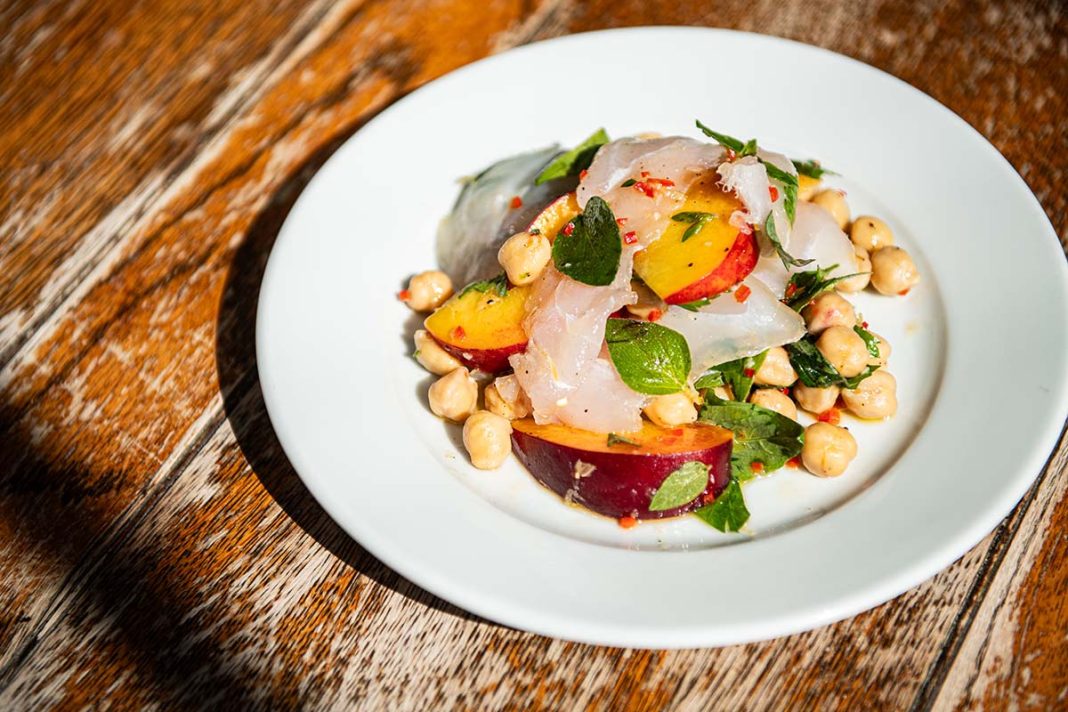These four summer recipes from The Palmerston, Edinburgh, prove that you needn’t sacrifice flavour when striving for elegance
This unforgettable menu of refreshing summer recipes is built on the ripest fruit, most vibrant vegetables and richest seasonings that Scotland has to offer. Bring the flavours of the countryside to your table with a salted hake and seasoned peaches salad, grilled courgettes with Green Goddess dressing, roast tomato and mint tagliatelle, and an elderflower panna cotta to finish. Each of the summer recipes is written by chef Lloyd Morse who is co-founder and head chef at The Palmerston restaurant in Edinburgh’s West End, which opened in 2021 and champions nose-to-tail cookery and local produce. Lloyd’s style, which bears many of the hallmarks of classical European cooking, has been hailed as timeless. His taste? Impeccable.
Go ahead! Delight your next dinner guests with this beautiful selection of fragrant and nourishing summer recipes, complete with advice from chef Lloyd.
1. Salt hake with peaches and chickpeas seasoned with fresh oregano and chilli
Serves two
By Lloyd Morse, patron-chef at The Palmerston Edinburgh: “The first of my summer recipes is a joyful one. I used to snub my nose at pre-cooked chickpeas in restaurants, thinking it was always better to cook your own. That was until I worked for Skye Gyngell at Spring. She would buy Navarrico chickpeas from Spain and dress them like a salad, with loads of chilli, lemon zest and parmesan. It totally changed my mind about good quality pre-cooked chickpeas. This summer recipe is an easy salad for sunny days.”
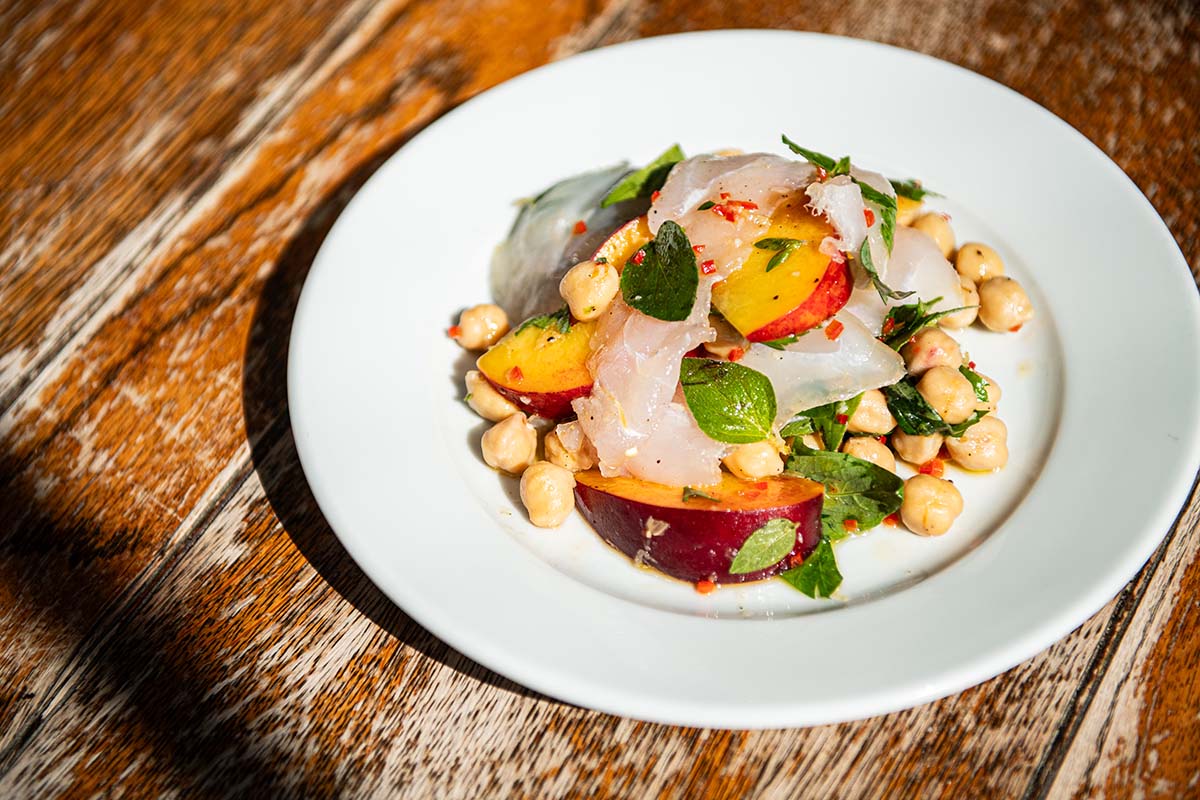
Ingredients
1 jar Spanish or Italian pre-cooked chickpeas
2 ripe peaches
250g hake fillet, cod or pollock
1 bunch oregano, leaves picked
½ a bunch of parsley, roughly chopped
1 long red chilli, finely diced, keeping the seeds depending on how spicy you like it.
Olive oil
1 lemon
5g maldon salt, plus more for seasoning
Method
- Generously sprinkle the salt on the fish fillet, place in the fridge and leave for one hour. After the hour, gently wash the fish in cold water and pat dry. Slice thinly, and return to the fridge.
- Strain the chickpeas, place in a bowl and dress generously with olive oil, lemon juice and zest, diced chilli, salt and pepper. Taste, they should be nicely balanced between the acid, oil and spice. The chickpeas are always best left like this left for an hour, so all the flavours can mingle, but it’s not essential.
- When ready to serve, slice the peaches, and add them along with the oregano, parsley and fish. Gently mix everything together and taste.
2. Grilled courgettes with Green Goddess dressing and dukkah
Serves four
By Lloyd Morse, patron-chef at The Palmerston Edinburgh: “This is one of my favourites in this selection of summer recipes. I think courgettes are best cooked grilled over an open flame. You almost need to burn them when grilling, as a bit of charring and smoke really enhances their sweet flavour.”
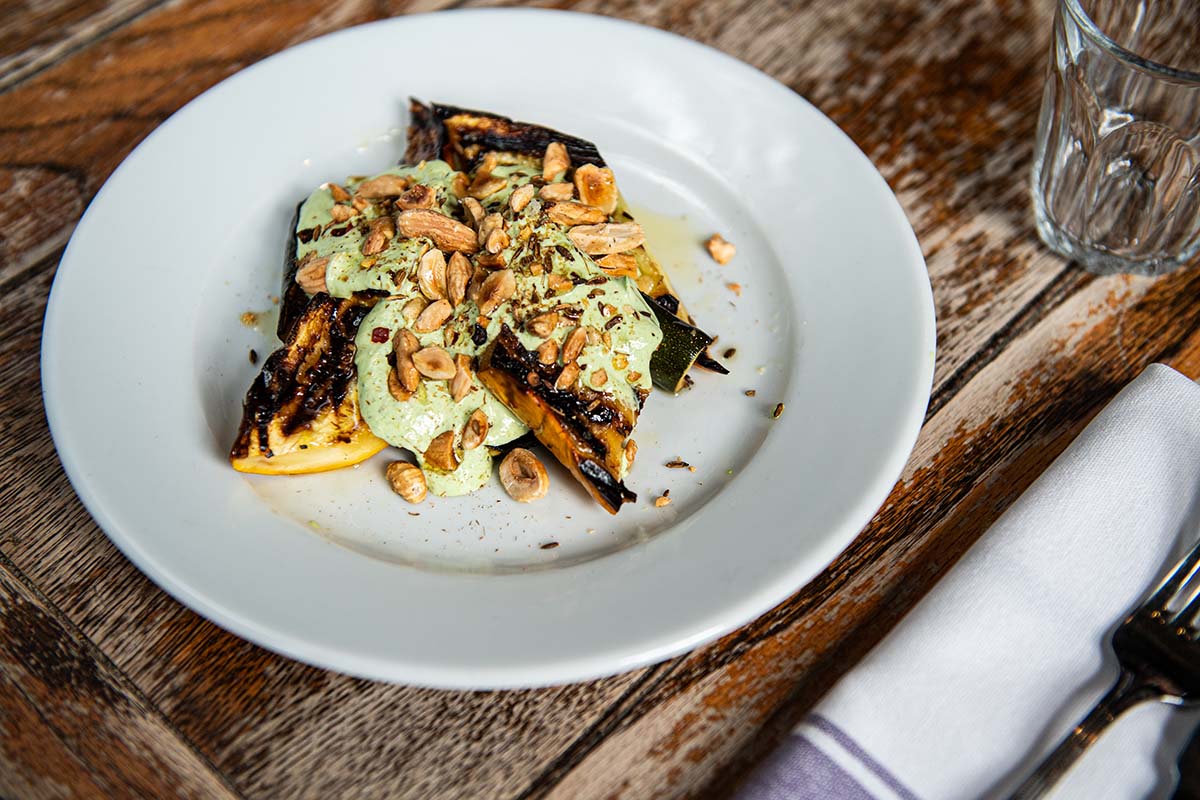
Ingredients
One large or two medium courgettes per person
For the Green Goddess dressing
300g greek yoghurt
80ml olive oil
4 cloves of garlic
1 lemon, zested and juiced
Two handfuls of soft green herbs (parsley, mint, basil, coriander, oregano)
For the Dukkah
100g whole almonds
100g whole blanched hazelnuts
5g fennel seeds
10g cumin seeds
5g dried chilli flakes
Method
- Slice the courgettes in half lengthwise. Season with salt and olive oil, and place cut side down on to grill or a frying pan on medium heat.
- Cook without turning until the courgettes have a deep dark colour, nearly burnt.
- Flip and grill for another minute or two on the other side, don’t give the opportunity to overcook, let them stay a little under.
- Remove from the grill and place on a plate or platter. While still hot, sprinkle some nice salt over them and a good grind of fresh black pepper. Dress liberally with the green goddess dressing and then dukkah.
For the Green Goddess dressing
- Blend four cloves of garlic with 250g yoghurt and 50ml olive oil.
- Roughly chop your choice of herbs and lemon zest, then blend with the yoghurt, taking care not to blend for too long, as the herbs may oxidise and blacken.
For the dukkah
- Preheat the oven to 180C.
- Toast the nuts together in the oven until golden brown.
- Toast the spices all together until fragrant and a little coloured.
- Semi crush the nuts in a pestle and mortar, you want some completely crushed and some just a little crushed.
3. Tagliatelle in a roast tomato sauce, elevated with creme crème fraîche and mint
Serves two
By Lloyd Morse, patron-chef at The Palmerston Edinburgh: “Spaghetti and a tomato sauce filled with oil and garlic will always be my favourite pasta sauce. This is just a different way to cook the tomatoes that brings a bit more depth to the sauce – caramelisation always means flavour!”
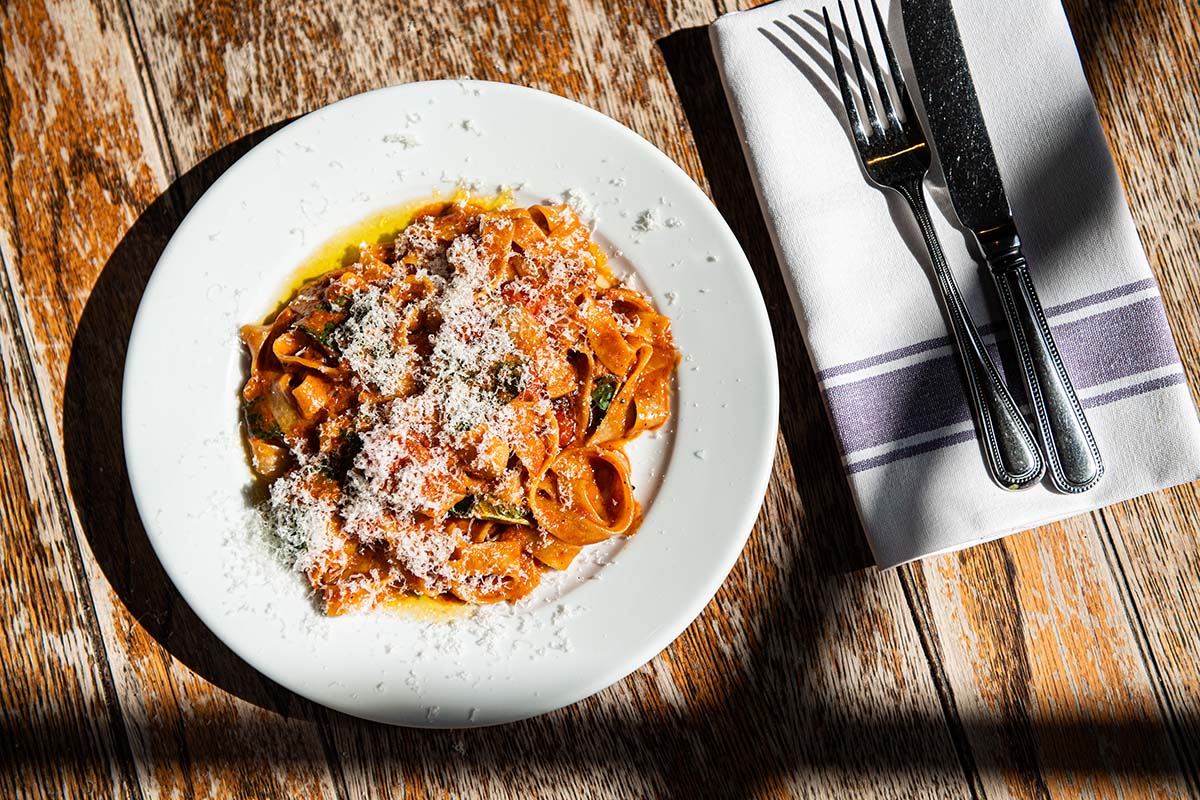
Ingredients
1kg whole cherry or plum tomatoes
Olive oil
Red wine vinegar
100g crème fraîche
Picked mint leaves
200g dried long pasta, tagliatelle or spaghetti
Parmesan, to serve
Method
- Preheat your oven as hot as it will go, 250c-300c.
- Once hot, place a dry oven tray in the oven and allow it to heat up. The tray needs to be large enough to hold the tomatoes in one layer, if they’re piled on top of each other they’ll steam and you won’t get the desired roasted taste. Carefully add the dry tomatoes to the oven tray and return to the oven.
- After five minutes open the oven and give the tray and shake, the tomatoes should begin to blister and black marks on them. Continue to roast the tomatoes, shaking every five to ten minutes, until they have deep colour on them and have started to split open.
- Now, carefully, add a sprinkle of salt and a very generous glug of oil. Give the tomatoes a good stir and allow to sit for five minutes out of the oven.
- If you have a food mill or mouli, pour all the contents of the roasting tray into the mill and pass it over a pot. If you don’t have a mill, then pour all the tomatoes into a pot and go over it with a potato masher a few times to break all the tomatoes up.
- Put the pot on a medium heat, add pepper and a little red wine vinegar, have a taste and let the sauce cook and reduce, generally it’ll be a little wet and need to thicken. Once the sauce is looking thicker, add the crème fraîche, mix and have a last taste for seasoning.
- Cook your pasta, drain and add to the sauce. Cook the sauce and pasta together for a few minutes to allow the pasta to soak up some of the sauce, add some torn mint and then a good grating of parmesan.
4. Elderflower panna cotta and roast nectarine
Serves four
By Lloyd Morse, patron-chef at The Palmerston Edinburgh.
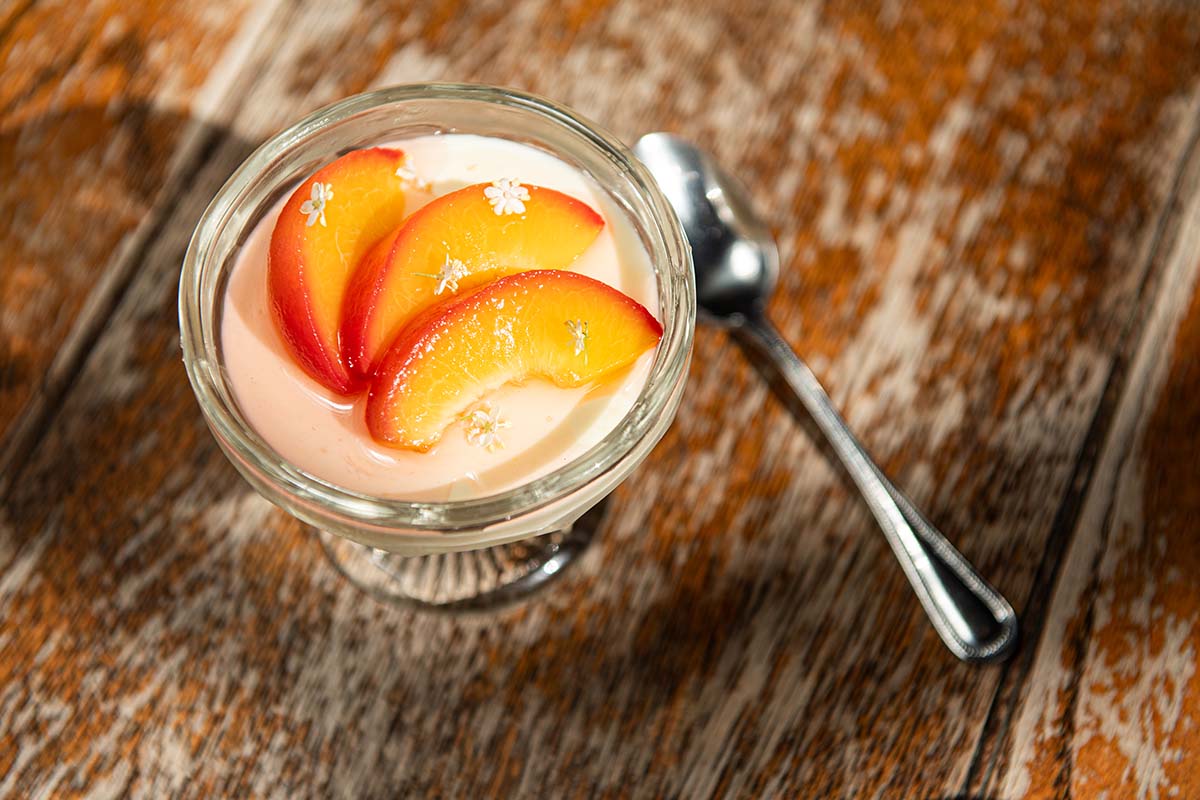
Ingredients
For the panna cotta
225ml double cream
75ml milk
35g sugar
1 leaf bronze gelatine
180ml elderflower cordial
For the roast nectarines
4 nectarines
1 lemon
45g sugar
Method
- Soak your gelatine leaf in the milk, ensuring it is fully submerged, cut it up if need be.
- Meanwhile, heat the cream and sugar together until almost boiling.
- Once the gelatine has softened, pour the milk and gelatine into the hot cream and mix over a medium heat until the gelatine has completely dissolved.
- Pass the mixture through a sieve and allow to cool to room temperature.
- Once cool, stir through the elderflower cordial, set in a mould and refrigerate until set.
- For the nectarines, halve the fruit and remove the stone, then toss in sugar. Using a peeler, zest strips of lemon into the sugary fruit, then squeeze in the juice. Allow this to sit for about 10 minutes while you preheat your oven to 150°C.
- Place the nectarines skin side up in a baking dish and cover with tin foil. Bake for around 20 minutes, or until just tender. Leave to steam out of the oven for 10 minutes with the foil still on, then carefully remove the nectarine skins.
- Serve atop the panna cottas with plenty of the fruity syrup from the bottom of the dish.
Click below for more chef-standard summer recipes to try at home. This time, a selection of small plate dishes by famed Glasgow restaurant, Margo.
Bring restaurant dining home with these fragrant recipes from Margo


